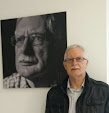I thought I would start this new blog with a record of paintings that I have either completed recently, or am currently working on.
This first post is therefore removed from its original position in www.artistsinpastel.com, April 2010, and re-posted here.
Je voulais ébaucher une nouvelle page sur les tableaux récemment achevés, ou sur lesquels je travaille actuellement. Cela semble être le style de la plupart des blogs sur la peinture, et je tiens à garder le blog principal distinct de mon propre travail.
Ce premier post est donc supprimé de sa position d'origine dans www.artistsinpastel.com, avril 2010 et re-publié ici.
This post is a example of how I use Photoshop as a tool for analysing a complex piece, and simplifying the painting process. This painting was based on a series of photographs taken at a horse fair in Ireland, and in particular the photograph posted here.
Because the photo was so busy, I needed to lose unnecessary information, like the grille on the window, the post in the centre of the image, and the trailer to the left. I also wanted to see the tonal balance, so I used photoshop to view a monochome version.

The darkest dark is in the top left corner window, with a touch in the tail of the horse on the right; the brightest light is on the top of the rump of the right horse, but even more in the woman's trousers.
My next task was to reduce the colours to an intelligible number. I used Photoshop to reduce the image to a 16-colour version, thus:
I then matched my pastels as near as possible to the sixteen colours, (mostly Rembrandt, but some Sennelier) which I identified as follows: White, Light Blue Grey (R. 707.9), Deep Blue Grey (R. 547.9), Olive green R. 620.5), Light Green (S. 174), Light Pink (S. 946), Deep Pink (S), Purple Pink (R. 347.5) , Deep Green (unidentified R. fragment), Plum Grey(unidentified R. fragment), Muddy Green (unidentified R. fragment), Light Brown Pink (R. 231.3), Brown (R. 371.3, Deep Purple (R. 538.5), Buff (R. yellow ochre), Light Blue (unidentified R. fragment). Mind you, this was an underpainting, so all these base notes were going to be pretty well covered.
The drawing was done with pastel pencil approximating the base colours where they were to be laid in, on a cream-buff support.
The first lay-in established both tone and underpainting simultaneously.
I then started to refine the features of the characters in the painting, without getting into the final overpainting just yet.
Now I was ready to begin an overlay with softer pastels, almost all of them from the Sennelier range. These are almost pure colour, soft and friable with very little filler.
Further definition was needed in the pavement, clothing, windowframe, the horse's ears, the cellphone, and the background characters who were having their own conversation, which was the title of the piece - Conversations. (18 ins H x 18.5 ins W)












